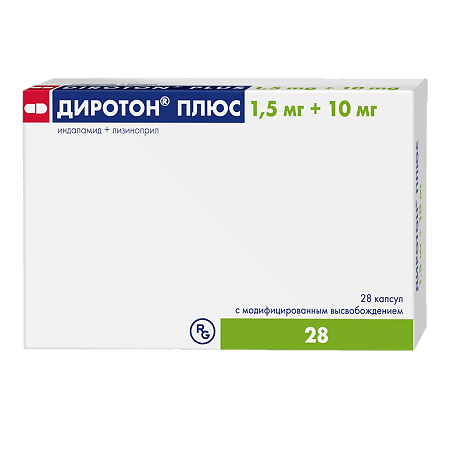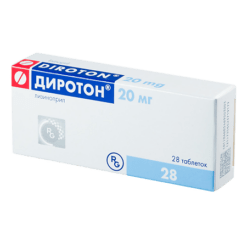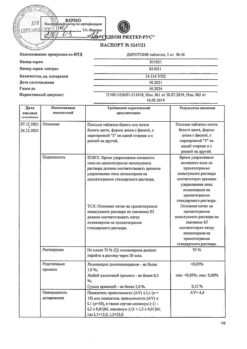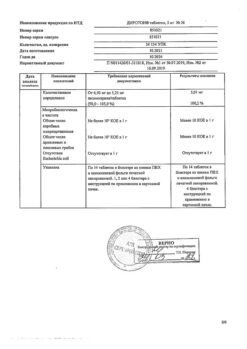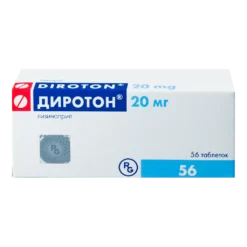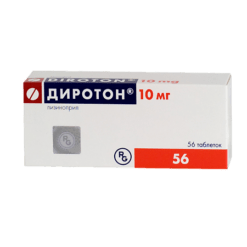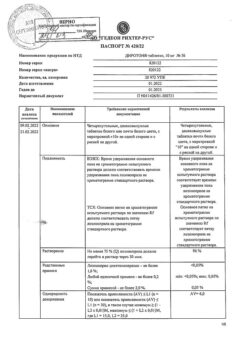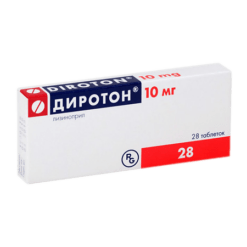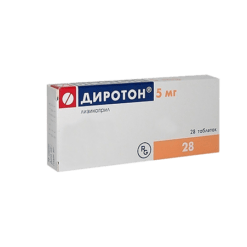No products in the cart.
Diroton Plus, 1.5 mg+10 mg 28 pcs
€13.96 €12.22
Description
Diroton® Plus is a combined preparation with fixed doses of lisinopril and indapamide.
Indapamide
It is a sulfonamide derivative containing indole ring. According to its pharmacological properties, indapamide is close to thiazide-like diuretics that inhibit sodium ion reabsorption in the cortical segment of the Genle loop.
This is accompanied by increased excretion of sodium, chloride and potassium ions and – to a lesser extent – magnesium ions, which leads to increased diuresis and antihypertensive effect. In phase II and III clinical trials, use of indapamide as monotherapy in doses that do not cause a pronounced diuretic effect caused a 24-hour antihypertensive effect.
Antihypertensive activity of indapamide leads to improvement of elasticity index of large arteries and to reduction of total peripheral and arteriolar resistance.
Indapamide reduces left ventricular hypertrophy.
At certain doses the optimal therapeutic effect of thiazide and thiazide-like diuretics is achieved, but further increasing the dose increases the frequency of side effects. Thus, the dose should not be increased if the therapeutic effect is not achieved while using the drug in recommended therapeutic doses.
In short-, medium- and long-term studies in which patients with arterial hypertension participated, it was shown that indapamide:
- does not affect lipid metabolism, including the concentration of triglycerides, cholesterol, low and high density lipoproteins.
- does not affect carbohydrate metabolism, including in patients with diabetes.
Lisinopril
It is an inhibitor of angiotensin-converting enzyme ACE, which inhibits the conversion of angiotensin I to angiotensin II. A decrease in angiotensin II concentration leads to a direct decrease in aldosterone secretion. Lisinopril inhibits bradykinin degradation and increases prostaglandin synthesis. It reduces total peripheral vascular resistance, blood pressure, preload and pulmonary capillary pressure.
In patients with chronic heart failure, lisinopril increases the minute blood volume and increases myocardial tolerance to exercise. It dilates arteries more than veins. Some effects are attributed to the effect on tissue reninangiotensin systems. Long-term use reduces myocardial hypertrophy and resistive arterial wall hypertrophy.
Lisinopril improves the blood supply to the ischemic myocardium.
In patients with chronic heart failure, ACE inhibitors increase life expectancy; in patients with a history of myocardial infarction without clinical manifestations of heart failure, lisinopril slows the progression of left ventricular dysfunction.
Lisinopril begins to work within 1 hour after oral administration. Maximum effect is achieved within 6-7 hours; the duration of effect is 24 hours.
In patients with arterial hypertension, the effect is seen within the first days of treatment; stable effect occurs within 1-2 months of treatment. No cases of significant increase in blood pressure (BP) after abrupt withdrawal of the drug have been reported. Lisinopril reduces both BP and albuminuria.
In patients with hyperglycemia, lisinopril helps to restore impaired glomerular endothelial function.
In patients with diabetes mellitus, lisinopril has no effect on plasma glucose concentration; the drug is not associated with increased risk of hypoglycemia.
Indications
Indications
Active ingredient
Active ingredient
How to take, the dosage
How to take, the dosage
Interaction
Interaction
Interactions with indapamide
Indesirable drug combinations
Lithium preparations
. Co-administration of indapamide and lithium preparations may increase plasma lithium content by reducing excretion, leading to intoxication. If necessary, combined use of diuretics and lithium preparations is possible; however, the dose of preparations should be carefully selected and regular monitoring of lithium content in blood plasma should be conducted.
Combinations of drugs requiring special attention
Drugs that may cause pirouette-type arrhythmias:
Special Instructions
Special Instructions
Hepatic impairment
When prescribing thiazide and thiazide-like diuretics to patients with impaired liver function, hepatic encephalopathy may develop, especially in the presence of electrolyte imbalance. In this case it is necessary to stop diuretics use.
Photosensitization
Pictures of photosensitization have been reported with thiazide and thiazide-like diuretics. If photosensitization occurs with the background of therapy, withdrawal of these drugs is indicated. If it is necessary to continue treatment it is recommended to protect the skin from sunlight or artificial UV radiation.
Water-electrolyte balance
Plasma sodium content should be determined before the start of treatment. Regular monitoring of this parameter is indicated during the whole therapy period. All diuretics may cause hyponatremia, which can sometimes have very serious consequences.
Permanent monitoring of sodium content in plasma is necessary, since at the beginning of therapy this decrease may not be accompanied by the appearance of pathological symptoms. Monitoring of sodium content should be especially carefully performed in patients with cirrhosis and in elderly patients.
Potassium content in plasma
The therapy with thiazide and thiazide-like diuretics may cause sharp decrease of potassium content in plasma as well as development of hypokalemia. It is necessary to decrease maximum risk of hypokalemia (<3.4 mmol/l) in the following groups of patients: elderly patients, weakened patients, patients receiving combined therapy with other proguvoaritmic agents and agents that may prolong QT interval, patients with liver cirrhosis, peripheral edema and ascites, coronary insufficiency, heart failure.
In these patients, hypokalemia increases the toxic effects of cardiac glycosides and increases the risk of arrhythmias. In addition, patients with prolonged QT interval should be classified as high-risk, regardless of the presence of the above conditions or the effects of medications.
Hypokalemia, as well as bradycardia, is a condition that contributes to severe arrhythmias and, in particular, cardiac arrhythmias that can be fatal. Regular monitoring of plasma potassium in these groups of patients is indicated, starting from the first week of treatment. If hypokalemia is detected, appropriate therapy is indicated.
Plasma calcium content
It has been reported that thiazide and thiazide-like diuretics decrease renal calcium excretion that leads to a slight temporary increase of plasma calcium content. Hypercalcemia with clinical manifestations may be the result of previously undiagnosed hyperparathyroidism. In this case it is necessary to cancel diuretics before investigation of parathyroid gland function.
Plasma glucose
Control of glucose concentration in patients with diabetes mellitus is indicated, especially in the presence of hypokalemia.
Uric acid
In patients suffering from gout an increase in the frequency of attacks or aggravation of the course of gout is possible.
Diuretics and renal function
Thiazide and thiazide-like diuretics are most effective in patients with normal or slightly reduced renal function (adult blood plasma creatinine <25 mg/L or 220 μmol/L). Plasma creatinine concentration in elderly patients is evaluated depending on age, body weight and sex.
In the beginning of treatment, patients have decreased glomerular filtration rate due to hypovolemia, which may be associated with water and sodium ion loss due to diuretics. Due to this there may be increase of uric acid and creatinine concentration in plasma.
In the absence of renal dysfunction, such transient functional renal failure usually goes without complications, but the general condition of patients may worsen in the presence of renal failure.
Athletes
Since indapamide is part of the drug Diroton® Plus, a positive doping test in athletes is possible.
Lactose
The drug contains lactose, so it should not be taken by patients with rare hereditary galactose intolerance, lactase deficiency or glucose-galactose malabsorption syndrome.
Lisinopril-related
Symptomatic arterial hypotension
. The most common significant decrease in BP is associated with hypovolemia caused by the use of diuretics, decreased salt in food, dialysis, diarrhea, or vomiting.
In patients with chronic heart failure, regardless of whether it is associated with renal failure, arterial hypotension may develop. It has been found that in patients with severe heart failure this condition occurs more frequently due to administration of high doses of diuretics, hyponatremia or impaired renal function.
In these patients careful medical monitoring is required (careful selection of lisinopril and diuretics doses is indicated). The same indications apply to patients with coronary heart disease and cerebrovascular insufficiency in whom sharp decrease of BP can lead to myocardial infarction or stroke.
In case of significant decrease of BP the patient should be in horizontal position; intravenous infusion of 0.9% sodium chloride solution is possible.
Transient hypotensive reactions are not a contraindication for administration of the next dose of lisinopril.
In patients with chronic heart failure with normal or reduced BP, the use of lisinopril may lead to a decrease in BP; usually this is not a reason for discontinuing the drug. If hypotension is accompanied by clinical manifestations, dose reduction or discontinuation of lisinopril should be considered.
In patients at risk of symptomatic arterial hypotension (with low-salt or no-salt diet), regardless of the presence of hyponatremia, as well as in patients receiving high-dose diuretics, compensation of these conditions (hypovolemia or sodium deficiency) should be achieved before initiating treatment. Control of the effect of initial dose of lisinopril on blood pressure is indicated.
Acute myocardial infarction
The standard treatment (thrombolytics, acetylsalicylic acid, beta-adrenoblockers) is recommended.
Lisinopril may be used in combination with intravenous nitroglycerin or transdermal nitroglycerin.
In patients with acute myocardial infarction and risk of further deterioration of hemodynamics and worsening of symptoms after administration of vasodilators, therapy with lisinopril should not be started.
These patients include those with systolic BP <100 mm Hg and patients with cardiogenic shock. In patients with systolic BP <120 mmHg, dose reduction is indicated during the first three days after myocardial infarction. In patients with systolic BP <100 mm Hg, the maintenance dose should be reduced to 5 mg (or temporarily to 2.5 mg). In patients with persistent arterial hypotension (systolic BP <90 mm Hg for 1 hour or more) lisinopril withdrawal is indicated.
Renal dysfunction
In patients with chronic heart failure, a significant decrease of BP during ACE inhibitor therapy may worsen renal dysfunction.
In cases of acute renal failure have been reported.
In patients with bilateral renal artery stenosis or renal artery stenosis of the only renal artery during ACE inhibitors use there have been increased concentrations of serum urea and creatinine; usually these disorders were temporary and disappeared after discontinuation of therapy. They occurred more frequently in patients with renal insufficiency.
Patients with acute myocardial infarction and severe renal dysfunction (serum creatinine concentration >177 μmol/l and/or proteinuria >500 mg/day) lisinopril is contraindicated. If renal function abnormalities develop during treatment (serum creatinine concentration >265 μmol/l or doubling of baseline), lisinopril should be stopped.
Allergic reactions, Quincke’s edema
In rare cases, the development of angioedema of the face, extremities, lips, tongue, epiglottis and/or larynx has been reported during use of ACE inhibitors, including lisinopril. In such cases, immediate discontinuation of lisinopril is required; patients should be monitored until the symptoms are completely resolved. Usually angioedema of the face and lips is temporary and does not require treatment; however, antihistamines may be prescribed.
Hyneurotic edema of the larynx may be fatal. Swelling of the tongue, epiglottis or larynx may lead to secondary airway obstruction. In this case, 0.3-0.5 ml of 1:1000 adrenaline solution should be injected immediately subcutaneously, and the airway should be secured.
It has been reported that patients receiving ACE inhibitors of the Negro race had a higher incidence of Quincke’s edema than patients of other ethnic groups.
Patients with a history of Quincke’s edema unrelated to ACE inhibitor use have a higher risk of developing angioedema when using ACE inhibitors.
Anaphylactic reactions associated with Hymenoptera venom desensitization
In very rare cases, patients taking ACE inhibitors may develop life-threatening anaphylactic reactions during desensitization with Hymenoptera venom, so ACE inhibitors should be temporarily withdrawn before desensitization.
Patients on hemodialysis
Anaphylactic reactions have also occurred in patients undergoing hemodialysis e using high permeability dialysis membranes (e.g., AN69) with concomitant use of ACE inhibitors. In such patients, the use of other dialysis membranes or other hypotensive drugs is indicated.
Cough
Therapy with ACE inhibitors may cause cough, which should be considered in the differential diagnosis. Prolonged dry cough usually stops after discontinuation of ACE inhibitors.
Surgical interventions/general anesthesia
The use of hypotensive drugs during major surgical intervention or during general anesthesia may lead to inhibition of angiotensin II formation due to compensatory renin secretion. A significant decrease in BP associated with this effect can be prevented by increasing circulating blood volume.
Patients taking ACE inhibitors should inform the surgeon/anesthesiologist prior to surgical intervention (including dental procedures).
Plasma potassium
Cases of hyperkalemia have been reported.
Risk factors for hyperkalemia include renal insufficiency, diabetes, therapy with potassium-saving diuretics (spironolactone, triamterene and amiloride), use of potassium preparations and potassium-based salt substitutes, especially in patients with impaired renal function.
If combined use of lisinopril and these drugs is necessary, regular monitoring of plasma potassium is indicated.
Double RAS blockade
The simultaneous use of ACE inhibitors, angiotensin II receptor blockers or aliskiren increases the risk of arterial hypotension, hyperkalemia and renal function disorders (including acute renal failure). Thus, it is not recommended to prescribe ACE inhibitors, angiotensin II receptor blockers or aliskiren for dual RAAS blockade.
If there are absolute indications for dual RAAS blockade, it should be performed under close supervision of a specialist with frequent monitoring of BP, renal function and electrolyte content.
ACE inhibitors and angiotensin II receptor blockers should not be used simultaneously in patients with diabetic nephropathy.
Impact on driving and operating machinery
There are no data on the effect of lisinopril on driving and operating machinery. However, the possibility of dizziness should be considered. In this regard, caution should be exercised when driving motor transport and operating mechanisms.
Indapamide does not cause impairment of psychomotor functions, however some patients with blood pressure decrease may have various individual reactions, especially at the beginning of therapy or when prescribing additional hypotensive drug to the basic scheme of treatment. In this case, the ability to drive vehicles and operate machinery may be reduced.
Contraindications
Contraindications
Side effects
Side effects
Most adverse reactions (laboratory and clinical changes) are dose-dependent.
Blood and lymphatic system disorders: very rare – thrombocytopenia, leukopenia, agranulocytosis, aplastic anemia, hemolytic anemia.
Nervous system disorders: rare – asthenia, headache, paresthesia, dizziness; frequency is unknown – syncope.
Cardiovascular system disorders: very rare – arrhythmia, significant arterial hypotension; frequency unknown – ventricular tachycardia type “pirouette” (life-threatening condition).
Gastrointestinal disorders: infrequent – vomiting; rare – nausea, constipation, dry mouth; very rare – pancreatitis.
Renal and urinary tract disorders: very rare – renal failure.
Hepatic and biliary tract disorders: very rare – liver function abnormality; frequency is unknown – in case of hepatic insufficiency liver encephalopathy may develop; hepatitis.
Skin and subcutaneous tissue disorders: hypersensitivity reactions, mainly dermatological, in patients with predisposition to allergic and asthmatic reactions.
Frequently – maculopapular rash; infrequently – hemorrhagic vasculitis; very rarely – angioedema and/or urticaria, toxic epidermal necrolysis, Stevens-Johnson syndrome; frequency is unknown – possible deterioration in patients with acute systemic lupus erythematosus. Cases of photosensitivity reactions have been reported.
Impact on the results of laboratory and instrumental studies: frequency is unknown – prolongation of QT interval on ECG; increased concentration of uric acid and glucose – in patients with gout and diabetes treatment with thiazide and thiazide-like diuretics should be used with caution; increased activity of “liver” enzymes. In clinical trials hypokalemia was observed in 10% of patients (potassium content in plasma less than 3.4 mmol/l) and in 4% of patients – 3.2 mmol/l after 4-6 weeks of treatment.
Within 12 weeks plasma potassium content decreased, on average, by 0.23 mmol/l; very rarely – hypercalcemia; frequency is unknown – decrease of potassium content and development of hypokalemia, especially significant for risk group patients; hyponatremia accompanied by hypovolemia, dehydration and orthostatic hypotension. Concomitant reduction of chloride may lead to compensatory metabolic alkalosis, but its frequency and severity are insignificant.
Lisinopril-related
The most common adverse reactions include dizziness, headache, fatigue, diarrhea, dry cough, and nausea.
Blood and lymphatic system disorders: rare – decrease in hemoglobin and hematocrit; very rare – leukopenia, neutropenia, agranulocytosis, thrombocytopenia, anemia; frequency is unknown – erythrocytopenia.
Intrinsic system disorders: infrequent – skin rash, itching; rare – angioedema of facial area, angioedema of extremities, lips, tongue, epiglottis and/or larynx; very rare – interstitial angioedema; frequency unknown – fever, positive test for antinuclear antibodies, increased erythrocyte sedimentation rate, eosinophilia, leukocytosis.
Psychiatric disorders: infrequent – emotional lability; rarely – mental confusion.
Nervous system disorders: infrequent paresthesias, somnolence; rare – asthenic syndrome; frequency is unknown – twitching of the limbs and face muscles.
Chronic disorders: infrequent – pain in the chest; rarely – tachycardia, bradycardia, increasing symptoms of heart failure, atrioventricular conduction disorders, myocardial infarction, palpitations.
Vascular disorders: frequently – marked BP decrease; rarely – orthostatic hypotension; frequency unknown – vasculitis.
Respiratory system, thoracic markers and mediastinum disorders: very rare – bronchospasm; frequency unknown – dyspnea.
Gastrointestinal disorders: infrequent – dyspepsia, dysgeusia, abdominal pain; rare – dry mouth; very rare – pancreatitis; frequency unknown – decreased appetite.
Liver and biliary tract disorders: very rare – hepatic-cell and cholestatic jaundice, hepatitis.
Skin and subcutaneous tissue disorders: infrequent – skin itching; rare – urticaria, alopecia; very rare – sweating; frequency unknown – photosensitization.
Muscular and connective tissue disorders: frequency unknown – myalgia, arthralgia/arthritis.
Repnal and urinary tract disorders: frequent – renal dysfunction; rare – acute renal failure, uremia; very rare – oliguria, anuria; frequency unknown – proteinuria.
Gender and mammary gland disorders: infrequent – decreased potency.
Impact on the results of laboratory and instrumental studies: infrequent hyperkalemia, hyponatremia; rarely – increased liver enzymes activity, hyperbilirubinemia, increased concentration of creatinine and urea.
If any of the side effects listed in the instructions worsen, or if you notice any other side effects not listed in the instructions, tell your doctor.
Overdose
Overdose
Additional information
| Weight | 0.029 kg |
|---|---|
| Shelf life | 2 years. Do not use after the expiration date stated on the package. |
| Conditions of storage | Store at the temperature not more than 25 ° C. Keep out of reach of children. |
| Manufacturer | Gedeon Richter, Hungary |
| Medication form | modified-release capsules |
| Brand | Gedeon Richter |
Other forms…
Related products
Buy Diroton Plus, 1.5 mg+10 mg 28 pcs with delivery to USA, UK, Europe and over 120 other countries.

